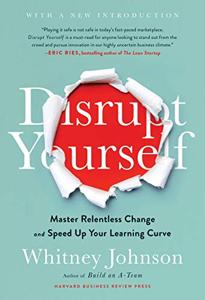
Want to learn the ideas in Disrupt Yourself better than ever? Read the world’s #1 book summary of Disrupt Yourself by Whitney Johnson here.
Read a brief 1-Page Summary or watch video summaries curated by our expert team. Note: this book guide is not affiliated with or endorsed by the publisher or author, and we always encourage you to purchase and read the full book.
Video Summaries of Disrupt Yourself
We’ve scoured the Internet for the very best videos on Disrupt Yourself, from high-quality videos summaries to interviews or commentary by Whitney Johnson.
1-Page Summary of Disrupt Yourself
Overview
The technology industry is one of the most innovative industries in the world. It’s always changing and churning out new ideas, products, and services. One minute a company can be happily leading the market; then suddenly its small competitor introduces something better than what it has to offer and takes over. Just look at Nokia, which was once a cell phone leader but now struggles to stay relevant as phones become more advanced. The engine driving all this change is disruption—companies big or small are constantly looking for ways to do things better or differently so they can crush their competitors with an innovation that catches them off guard and propels them ahead of the competition.
Disruption isn’t limited to business. You can disrupt yourself and gain success by doing so.
One lawyer was promoted to partner by disrupting his business model. He did this by looking for an unexpected shortage in the market, and then filling that gap with a new product or service. There’s also evidence that taking a step back can lead to success when you’re trying something new.
Big Idea #1: There are many types of risk; some are more important than others for success.
Have you ever considered skydiving? It might seem like fun, but before you try it, you should research the risks involved. That same philosophy applies to jumping into business.
If you’re going to take a business risk, it’s important to distinguish between two types of risks. One type is competitive risk, which can occur when you have an idea for a product or service that might be successful but there are already competitors who may try to beat you at your own game. A market risk occurs when the concept for your new product or service has never been done before and no one knows if it will succeed in the market.
Unusual ideas can help companies gain a competitive advantage.
When it comes to starting a business, the safest route is usually a competitive risk. However, that’s not necessarily the best option because you’re competing with companies in your industry who already have an established customer base. You can be more successful if you take on market risks and try to disrupt yourself by creating something new. Studies have shown that start-up businesses fare better when they take on market risks instead of competitive ones. In 1995, Harvard Business School professor Clayton Christensen conducted a study about computer disk drives and determined two types of disc drive companies had emerged between 1976 and 1993: those who took on market risks or competitive risks.
Of these companies, six percent of the ones that were more competitive had reached $100 million in revenue while 37% of those that took market risks had surpassed $100 million.
Big Idea #2: To be successful, identify your distinctive strengths and pair them with unmet needs in society.
Everyone has a special strength. Even the koala, who seems to be lazy and gentle, can digest poison-filled leaves that no other animal can.
In order to be successful in a competitive environment, you need to identify and develop your own distinctive strength.
In the film The Hundred Foot Journey, an Indian family flees to Europe during political uprisings in India. They open a restaurant and start serving food from their homeland. However, the local villagers are not interested in trying out this exotic fare. Eventually, a French neighbor takes Hassan under his wing and teaches him how to prepare French cuisine—a fusion of flavors that becomes popular with the locals. Likewise, you should aim your strengths toward some unmet need in society so that you can become successful at what you do best. For example, when Jayne Juvan started working for Roetzel & Andreas as a young lawyer, she noticed that her colleagues were not using social media to advertise their services. She began advertising on Twitter and Facebook herself, landing major clients before long.





